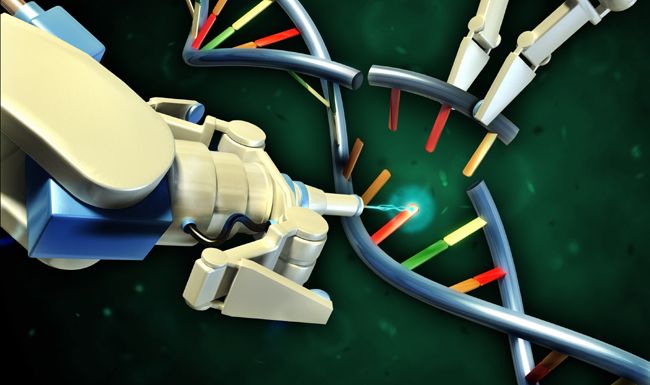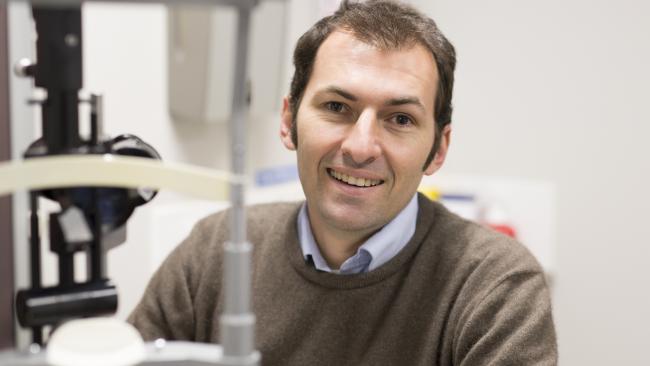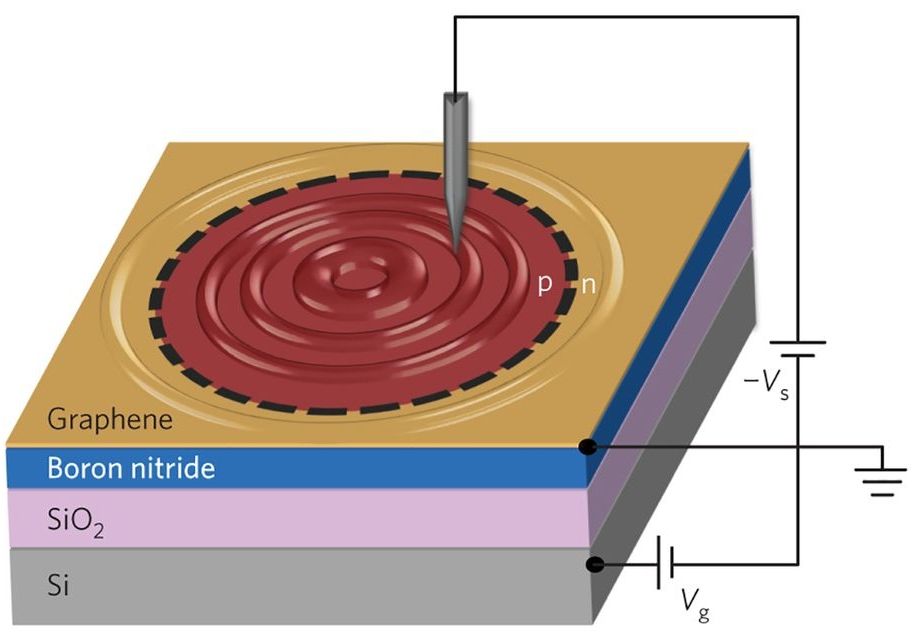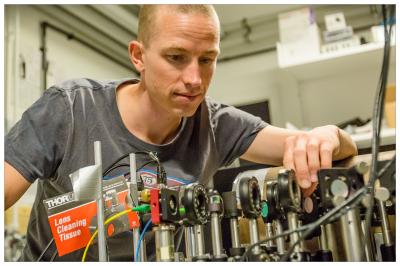Page 10832
Jul 15, 2016
New images of a calcium-shuttling molecule that has been linked to aggressive cancer
Posted by Karen Hurst in categories: biotech/medical, physics

Scientists have captured new images of a calcium-shuttling molecule that has been linked to aggressive cancers. The three-dimensional structure could help researchers develop novel therapies and diagnostic tools for diseases that are caused by a malfunction in calcium adsorption.
Alexander Sobolevsky’s lab at Columbia University Medical Center is studying a family of proteins called “Transient receptor potential (TRP)” channels. These proteins line surfaces inside the body, such as the intestine, and form pores that help calcium cross a dense barrier of lipid and protein called the membrane to reach the interior of the cell.
Jul 15, 2016
3D-Printed Gatling Gun Fires 48 Rubber Bands in Mere Seconds
Posted by Karen Hurst in categories: 3D printing, biotech/medical, cyborgs
Matthew Davis’ Arcus is officially the most impressive thing we’ve ever seen come out of a 3D printer. Sure, cheap prosthetics and replacement body parts are important uses of the technology, but this spinning rubber band blaster is what finally makes us want to put a 3D printer on our desks.
https://www.youtube.com/watch?v=r8PtwqRvVDU
Unlike most rubber band blasters that only fire a single shot every time you squeeze the trigger or require a drive mechanism to make them fully automatic, Davis’ Arcus uses the energy from the loaded elastics to spin the barrel and automatically fire shot after shot until it’s empty. Brilliant.
Continue reading “3D-Printed Gatling Gun Fires 48 Rubber Bands in Mere Seconds” »
Jul 15, 2016
The Rolls-Royce Phantom Now Has More Than 10,000 3D Printed Parts, BMW Looks to Expand Use Across Entire Line of Cars
Posted by Karen Hurst in categories: 3D printing, transportation
With more than 25 years of using 3D printing technology, there probably isn’t a global automotive manufacturer that has pushed the limits of using additive manufacturing applications than the BMW Group. For most of the quarter-century that they have been using 3D printing, it was primarily used in the production of prototypes or one-off custom parts. However BMW began using 3D printing technology to produce end-use parts in series production back in 2012 with their new Rolls-Royce Phantom. Over the next several years, more than 10,000 3D printed components would end up being used to manufacture each Phantom coupe that came off the assembly line. The switch from traditionally manufactured parts to 3D printed parts was so successful that BMW began incorporating them into the new Rolls-Royce Dawn this year.
Every wanted to reverse silent genes without mutations created? We now have a way.
Researchers have developed a technique that turns back on silenced, or switched-off, genes without causing unwanted mutations.
Jul 15, 2016
Should a human-pig chimera be treated as a person?
Posted by Karen Hurst in categories: bioengineering, biotech/medical, genetics
There is a well-documented organ shortage throughout the world. For example, 3,000 kidney transplants were made last year in the United Kingdom, but that still left 5,000 people on the waiting list at the end of the period. A lucrative trade in organs has grown up, and transplant tourism has become relatively common. While politicians wring their hands about sensible solutions to the shortage, including the nudge of opt-out donation, scientists using genetic manipulations have been making significant progress in growing transplantable organs inside pigs.
Scientists in the United States are creating so-called ‘human-pig chimeras’ which will be capable of growing the much-needed organs. These chimeras are animals that combine human and pig characteristics. They are like mules that will provide organs that can be transplanted into humans. A mule is the offspring of a male donkey (jack) and a female horse (mare). Horses and donkeys are different species with different numbers of chromosomes, but they can breed together.
In this case, the scientists take a skin cell from a human and from this make stem cells capable of producing any cell or tissue in the body, known as ‘induced pluripotent stem cells’. They then inject these into a pig embryo to make a human-pig chimera. In order to create the desired organ, they use gene editing, or CRISPR, to knock out the embryo’s pig’s genes that produce, for example, the pancreas. The human stem cells for the pancreas then make an almost entirely human pancreas in the resulting human-pig chimera, with just the blood vessels remaining porcine. Using this controversial technology, a human skin cell, pre-treated and injected into a genetically edited pig embryo, could grow a new liver, heart, pancreas or lung as required.
Continue reading “Should a human-pig chimera be treated as a person?” »
Jul 15, 2016
Five Things to Know About the New GMO Labeling Bill
Posted by Karen Hurst in category: government
Congress just passed a bill requiring GMO labeling, but it’s not as straightforward as you might think.
Jul 15, 2016
Inherited eye disease breakthrough within sight of Tassie-led research team
Posted by Karen Hurst in categories: biotech/medical, innovation
A POSSIBLE cure for inherited eye diseases which cause blindness is within sight thanks to a breakthrough recorded by a Tasmanian-led research team.
Associate Professor Alex Hewitt, an ophthalmologist and a researcher with the University of Tasmania’s Menzies Institute for Medical Research and the School of Medicine, said his team had successfully edited adult eye tissue genes in the laboratory to replace unwanted genes that caused blindness.
Dr Hewitt said he was optimistic Tasmanian doctors could soon start wielding molecular gene shears inside the eyes of humans.
Jul 15, 2016
Images made of relativistic electrons trapped in graphene quantum dots
Posted by Karen Hurst in categories: nanotechnology, particle physics, quantum physics
(Phys.org)—A team of researchers with the University of California, MIT, Lawrence Berkeley National Laboratory and the National Institute for Materials Science in Japan has created images of relativistic electrons trapped in graphene quantum dots. In their paper published in the journal Nature Physics the team describes how they achieved this feat and where they plan to take their work in the future.
As the many unique properties of graphene continue to unfold, scientists seek new ways to harness and eventually make use of them. One such use might be to control electrons to allow their use in nano-scaled devices, which could also inadvertently lead to a deeper understanding of Dirac fermions. In this new effort, the researchers have made progress in that area by devising a means for capturing and holding electrons and for creating images of the result.
Obtaining images of electron waveforms has thus far been particularly difficult—virtually all existing methods have resulted in too many defects. To get around such problems, the researchers took another approach to capturing the electrons. They first created circular p-n junctions by sending voltage through the tip of a scanning tunneling microscope down to a graphene sample below. At the same time, they also applied voltage to a slab of silicon underneath the piece of graphene, which was kept separated by a layer of silicon-oxide and a flake of boron nitride. Doing so caused defects in the boron nitride to ionize, resulting in charges migrating to the graphene.
Continue reading “Images made of relativistic electrons trapped in graphene quantum dots” »
Jul 15, 2016
Optical magnetic field sensor can detect signals from the nervous system
Posted by Karen Hurst in categories: neuroscience, quantum physics
Quantum physics: The human body is controlled by electrical impulses in, for example, the brain, the heart and nervous system. These electrical signals create tiny magnetic fields, which doctors could use to diagnose various diseases, for example diseases of the brain or heart problems in young foetuses. Researchers from the Niels Bohr Institute have now succeeded in developing a method for extremely precise measurements of such ultra-small magnetic fields with an optical magnetic field sensor. The results are published in the scientific journal, Scientific Reports.
Assistant Professor Kasper Jensen in the Quantop research group’s laboratories at the Niels Bohr Institute where the experiments are carried out. (Photo: Ola Jakup Joensen)
Small magnetic fields from the human body can usually only be picked up by very sensitive superconducting magnetic field sensors that have to be cooled by liquid helium to near absolute zero (which is minus 273 degrees Celsius). But now researchers from the Niels Bohr Institute at the University of Copenhagen have developed a much cheaper and more practical optical magnetic field sensor that even works at room temperature or at body temperature.
Continue reading “Optical magnetic field sensor can detect signals from the nervous system” »

















